Paulus Potter
Paintings
Four cows in the pasture
Cattle and Sheep
Cattle in a Field with Travellers in a Wagon on a Track beyond and a Church Tower in the distance
Two cows and a goat by a pollarded tree in a landscape with other cows in the distance
A Landscape with Cows Sheep and Horses by a Barn
The bear hunt
A Farrier's Shop
Two Pigs in a Sty
Abraham at Sichem
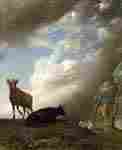
Cattle and Sheep in a Stormy Landscape
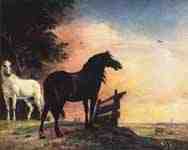
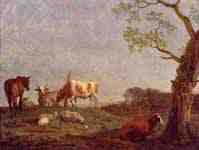
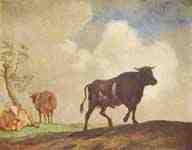
Drawings
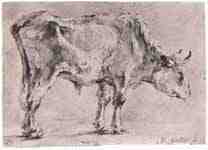
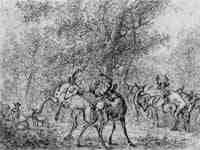
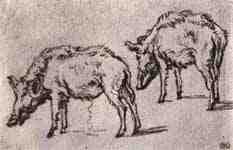
Fine Art Prints | Greeting Cards | Phone Cases | Lifestyle | Face Masks | Men's , Women' Apparel | Home Decor | jigsaw puzzles | Notebooks | Tapestries | ...
The Piebald Horse
Paulus Potter (20 November 1625 (baptised) – 17 January 1654 (buried)) was a Dutch painter who specialized in animals within landscapes, usually with a low vantage point.

Before Potter died of tuberculosis at the age of 28 he succeeded in producing about 100 paintings, working continuously.
Life
Few details are known of Potter's life. He was born in Enkhuizen. In 1628 his family moved to Leiden, and in 1631 to Amsterdam, where young Paulus studied painting with his father, Pieter Symonsz Potter.[1] After his mother died, his father started an affair with the wife of Pieter Codde, also living in the fancy Sint Antoniesbreestraat. For some time his father was a manufacturer of gilded leather hangings outside the city walls.
Potter became a member of the Guild of Saint Luke in Delft, but by 1649, Paulus moved to The Hague, next to Jan van Goyen. Potter married in the Hague and his father-in-law, who was the leading building contractor in the Hague, introduced him to the Dutch elite.[1] Amalia of Solms-Braunfels, a member of the stadholder's family and an art-lover, bought a painting with a pissing cow,[2] but some court ladies seemed to have advised against it. By May 1652, after a case about delivering a new painting, he returned to Amsterdam. Potter was invited by Nicolaes Tulp, who was impressed by his civilized behavior and politeness. Potter painted his son Dirck Tulp, but only changed the face on an earlier work he was not able to sell. Potter died in Amsterdam.
Paulus painted a self-portrait which was at Hackwood Park, Hampshire until 1998. It is now at Elibank House, Buckinghamshire.
Paintings
Herd Rijksmuseum
His most famous painting not to be confused with his work "The Bull" is The Young Bull (circa 1647), that is now in Mauritshuis in The Hague, composed after drawings Potter made in nature. Though this painting was criticized, it was greatly admired during the 19th century as an early example of Romanticism. The Young Bull features as the canvas being studied in Mark Tansey's 1981 monochromatic oil on canvas The Innocent Eye Test.
References
Liedtke, Walter A., Michiel Plomp, and Axel Rüger. 2001. Vermeer and the Delft school. New York: Metropolitan Museum of Art. ISBN 0-87099-973-7 p. 332.
"Paulus Potter (1625-1654) Painter of landscape and animal pieces. Born in Enkhuizen, in the Delft Guild from 1646-1649". Xs4all.nl. Retrieved 2014-04-10.
---
Fine Art Prints | Greeting Cards | Phone Cases | Lifestyle | Face Masks | Men's , Women' Apparel | Home Decor | jigsaw puzzles | Notebooks | Tapestries | ...
---
Artist
A - B - C - D - E - F - G - H - I - J - K - L - M -
N - O - P - Q - R - S - T - U - V - W - X - Y - Z
Retrieved from "http://en.wikipedia.org/"
All text is available under the terms of the GNU Free Documentation License












